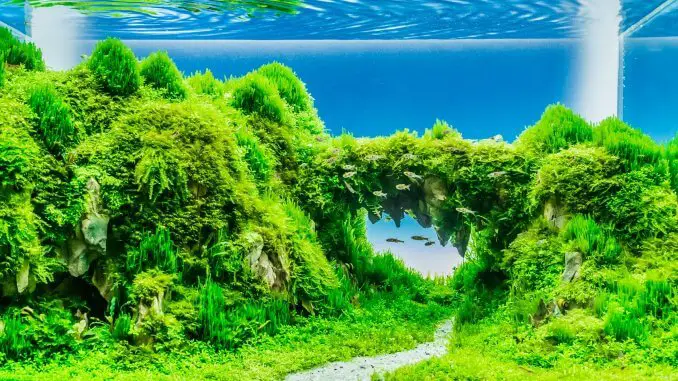
Planted aquariums can be extremely beneficial for your fish as well as look great.
They provide the aquarium with essential dissolved oxygen as well as additional filtration.
A lot of people keep fake plants because they think that planted tanks are too expensive and require a lot of maintenance.
This however is not true. There are a lot of easy beginner plants and popular fish out there to get you started into the world of planted tanks.
Within this article, we cover everything you need to know about planted aquariums. From some of the plants and fish, you can stock, to how to set up a planted tank and different ways you can scape it.
Easy Aquarium Plants
Let’s start by looking at some of the easiest and most beautiful aquarium plants to keep in home aquariums.
Vallisneria
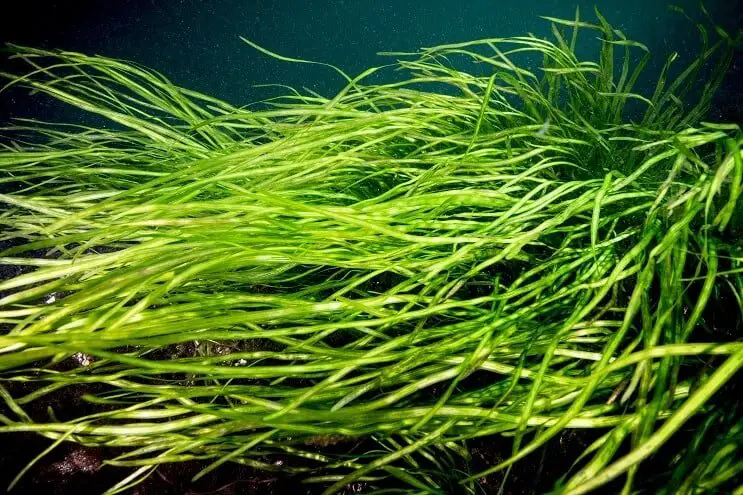
Vallisneria also goes by the name American Eelgrass due to its appearance (it has long flattened green or red leaves).
They should be planted into a coarse substrate as it will provide good aeration and allow essential nutrients to mix and the roots to branch out.
It’s a very hardy and fast-growing species which makes it ideal for beginner hobbyists.
Amazon Sword
The Amazon Sword plant is native to the tropical freshwaters of the Amazon Basin in South America. Because of this, they grow best in waters with a temperature of 60-83°F and a pH of 6.5-7.5.
This has long broad leaves which bear a resemblance to swords or the head of a spear. These leaves can grow up to 20 inches in length and provide the perfect location for freshwater Angelfish to lay their eggs as they would in the wild.
Planting them into a coarse substrate like gravel allows the roots to take hold much quicker as it provides space for them to extend as well as allowing the water to mix through and add beneficial nutrients.
Java Fern
Java Fern is a great beginner plant species for many different reasons.
They are able to adjust to vast arrays of different conditions such as being able to grow well under low to moderate lighting conditions.
These plants need to be attached to wood using either twine or a fishing line to allow them to attach on their own using their root systems. Alternatively, you can also plant these plants into a coarse aquarium soil and substrate which can supply plenty of nutrients required for growth.
Java Moss

Java Moss is found growing on rocks and submerged tree trunks in tropical rivers and streams throughout Southeast Asia. It is a hardy species as it is able to accept a wide range of water conditions.
These can vary from poor to direct light in aquariums with a temperature of 59-86°F with a pH of 5.0-8.0.
Java Moss is so simple to propagate that you will soon have a large colony of it to spread throughout your aquariums or trade with other hobbyists. All you need to do is cut out a chunk of it from the main clump and place it elsewhere where it can continue to grow.
American Waterweed (Elodea)
American Waterweed or Elodea (as it is also known) grows best when provided with direct light and planted into the aquarium substrate. Although it can also grow perfectly well when left free-floating in the tank or when weighed down.
It is a fully aquatic species and grows completely beneath the water except for when it blooms small white flowers at the surface.
The greatest thing about this plant is its exceptional ability to produce huge quantities of dissolved oxygen which is vital for the respiration of all living organisms. This makes it a perfect plant for all freshwater aquariums.
Best Fish For Planted Aquariums
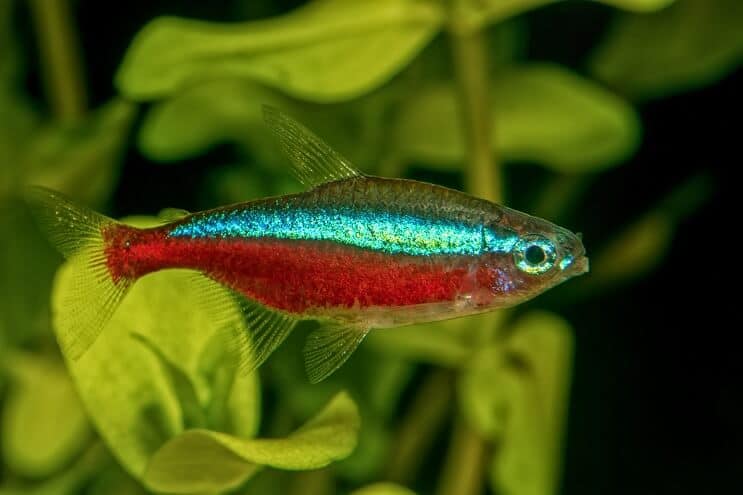
There are a variety of different fish and other organisms which can be kept in planted tanks.
These living organisms have a symbiotic relationship with one another, the fish create waste which is converted into nitrates (an essential nutrient for plant growth) and the plants produce oxygen.
Generally small colorful shoaling fish provide a great contrast to the lush green planted environment. You could include:
Because the leaves of plants provide the perfect habitat on which unwanted algae will grow, fish like Otocinclus Catfish and Siamese Algae Eaters will do a fantastic job of eating it and therefore keep the plants healthy.
Planted aquariums also provide the ideal habitat for larger freshwater species like Rainbowfish, Discus, and Angelfish.
You should avoid keeping any herbivorous fish species in your planted aquariums, particularly if you are keeping expensive plants as these fish will eat your plants.
Fish like Silver Dollars, Buenos Aires Tetra, and Mbuna Cichlids are notorious for doing this.
Types Of Planted Aquariums

There are a lot of different plants to choose from and there are many different ways in which you can arrange them.
Planted aquariums also go by the name aquascaping which is essentially underwater gardening.
There are various different aquascape styles and below we will discuss two of the most popular types.
Dutch Aquascape
As its name suggests, this style of aquascape comes from Holland’s popular culture of flower and plant arrangement.
It is done in such a way that creates colorful scenery with different sized, shaped, and colored plants placed into beds, rows, and columns to contrast one another.
Large aquariums are a must for this style as there needs to be plenty of space due to a large number of plants.
Unlike the popular natural style of aquascapes which we will come onto shortly, this style does not incorporate hardscapes or ornaments within the tank but instead uses different kinds of plants to create a beautiful looking aquarium.
Carpeting plants are a must in this style.
Natural Aquascape
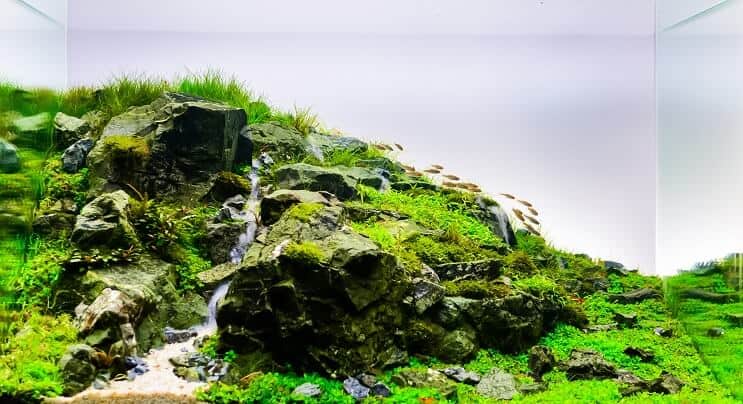
Natural aquascapes were introduced into the hobby by master aquarist Takashi Amano. He is also well known for adding a cleanup crustacean to his aquascapes (Amano Shrimps).
This kind of aquascape involves the use of hardscapes such as rocks, driftwood, or bogwood being specifically placed to become the centerpieces of the scape.
Not a lot of plants are used in this kind of aquascape, only a few different species of Moss and carpeting plants are usually planted.
Within these tanks, it is commonplace to keep smaller species of fish like Neon Tetras or Galaxy Rasboras.
How to Setup a Planted Aquarium
Step One: Research and Design
Before buying an aquarium, it is vital that you first research the plants, fish, and any other organisms you want to keep within it. You need to make a list and make notes on the specific requirements each one needs and see if they are compatible with one another.
Once you have done your research, you should have a rough idea of the size of aquarium you are going to need in order to achieve your dream tank.
Now that you know which plant species you want to keep another good thing to do would be to make some sketches of what you want the finished tank to look like. This will prevent unnecessary rearrangement later, which can disturb the substrate and cause cloudy water.
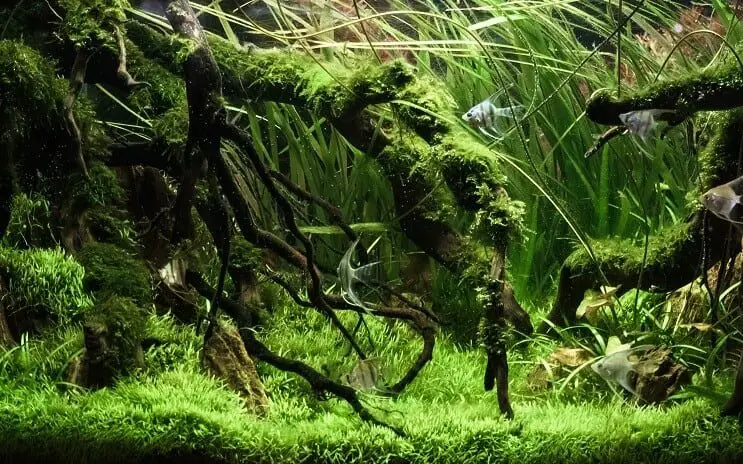
Step Two: Preparing the Aquarium
Whether you have purchased a new aquarium or a second-hand one, you will need to clean the tank. New tanks can have harmful chemicals leftover on the surface of the glass or acrylic.
When it comes to cleaning your aquarium, you should avoid using any detergents as they can also be harmful to plants.
Instead, the best thing you can use is vinegar and a cloth for glass aquariums.
Read our guide here for more information.
Step Three: Positioning the Tank
The location you choose to place your aquarium is very important.
If you place the tank in direct sunlight like on a window ledge, it can promote algae growth.
Species like hair algae, if not removed quickly can outcompete your plants for resources.
Locations that can raise the temperature of the tank also cause the same problem.
Somewhere that is cool and out of direct sunlight is perfect. Just make sure you have a power outlet nearby in order to run the essential equipment.
Step Four: Adding the Substrate, Plants, and Water
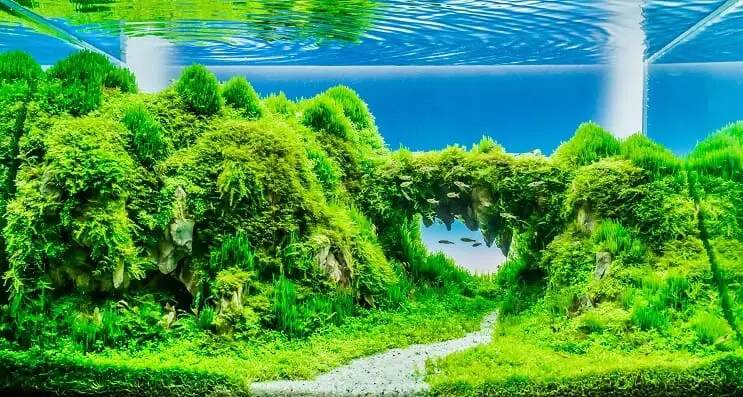
Now that you have the tank in place, you can begin to add the substrate layers to the bottom of the tank. For planted aquariums, it is recommended that you first place a soil-based substrate that will provide nutrients to the plants.
Start by adding a 1-inch layer of this substrate to the tank and spread it across the tank evenly. Then add a 1-inch gravel layer on top, to prevent the soil from mixing with the water.
Now that the substrate is in place, you can begin to plant your different aquatic plants.
The next thing to do is to add pre-conditioned water to the aquarium. Conditioning the water before is essential because it removes Chlorine, Chloramine, and other chemicals and traces elements that are harmful to the beneficial bacteria required in the nitrogen cycle.
Step Five: Adding the Equipment
Next, you need to add the essential equipment required for maintaining a healthy aquarium.
The first piece of equipment you need for your planted tank is a filtration system (make sure it has a capacity matching or exceeding the size of your aquarium).
Lighting is also vital and enables plants to photosynthesize and therefore maintain healthy growth. LED lighting is extremely popular and extremely efficient – 10-12 hours of daily light will be enough.
Heaters are also important but not always necessary, it depends on whether you keep tropical or cold water species in your aquarium.
Carbon dioxide injection systems can aid in the growth of your aquarium plants, but they also are not always necessary. The plants discussed earlier in the article will grow well without this expensive piece of kit.
Step Six: Cycling the Tank
This is the most important step in setting up a planted aquarium.
At the start of the cycle, you are going to need to add small quantities of ammonia to help the beneficial bacteria to establish. Around 2-4 parts per million (ppm) should be enough for day one, with an extra 1ppm to be added every other day.
Be sure to check your ammonia, nitrite, and nitrate levels weekly as it can take 6 to 8 weeks for the nitrogen cycle to be completed. You will know once it has because ammonia and nitrite levels will return to 0ppm.
Step Seven: Adding the Fish and Other Inhabitants
When your tank has completed the nitrogen cycle, the final step is to add your fish.
The first thing you need to do is place the plastic transport bags into the aquarium to acclimate your fish to avoid shock.
They should be left there for anywhere between 30 minutes to 1 hour.
When the temperature in the bags is the same as the tank, you should open the bags and place 1 cup of aquarium water into the bags every 5 minutes – repeat this for a period of 30 minutes.
After the 30 minute period is over, quickly but carefully place the fish from the net into the tank.
FAQs Planted Aquariums
How To Setup A Planted Tank?
The most important step in setting up a planted aquarium is to do your research. Different plants and fish require specific parameters in order to thrive and survive within an aquarium system. Throughout this article, we have provided you with an in-depth step-by-step guide for setting up a planted tank and we suggest that you closely follow each step.
How Long To Leave Aquarium Lights?
Different aquatic plants require different water parameters and lighting. There are many different species that will thrive in low light conditions however increased lighting will help them thrive. Generally, though you should be providing light for a period of 10-12 hours each day, in the region of 6000-6500 Kelvin
How To Get Rid Of Hair Algae?
There are a few different methods for removing hair algae from your aquarium. The first method is to manually remove it with your hands although a toothbrush is extremely effective at removing hair algae that have become intertwined with your plants.
Another method is to purchase some algae destroying chemicals from your local fish store – when using these chemicals be sure to follow the instructions on the packaging carefully as overuse of these chemicals may harm your aquarium plants.
Summary
Remember when choosing plants to add to your aquarium, there are countless species to choose from. All of which may require different water parameters which is why it is vital you do your research.
There are lots of different fish, shrimp, and snails which make excellent inhabitants for planted tanks.
Be careful though as herbivorous fish can destroy your little slice of Eden.
Also, avoid adding fish species like Goldfish to your planted tank as this will result in murky water.
What are your favorite aquatic plants? Let us know in the comments section below…

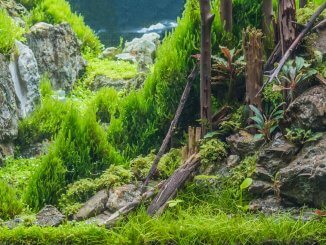
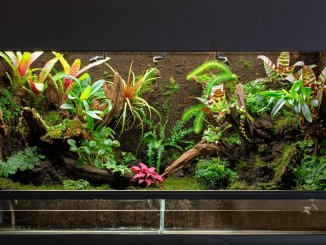

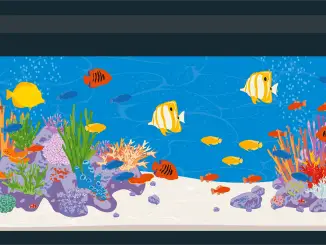
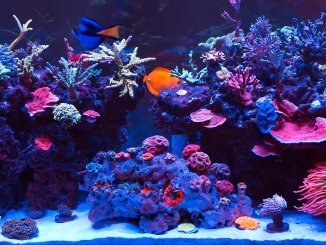
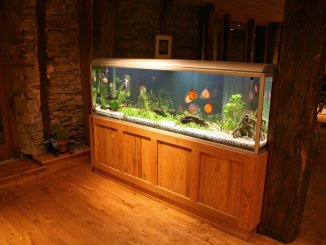
Very good information & which was very easy way explain. Thanks for it!